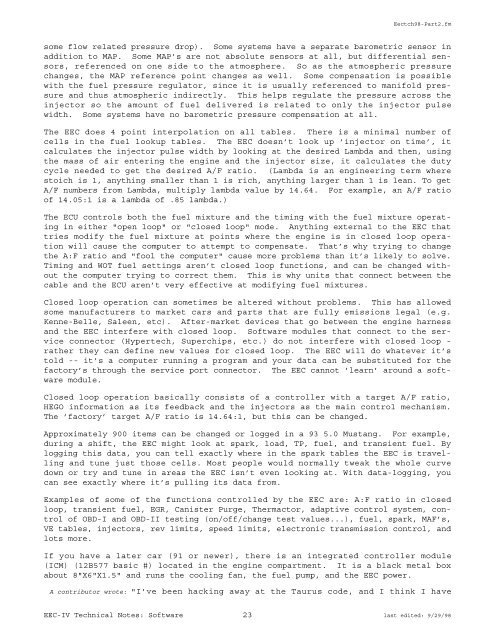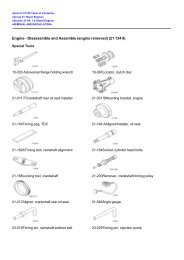TECHNICAL NOTES ON THE EEC-IV MCU - Auto diagnostics
TECHNICAL NOTES ON THE EEC-IV MCU - Auto diagnostics
TECHNICAL NOTES ON THE EEC-IV MCU - Auto diagnostics
Create successful ePaper yourself
Turn your PDF publications into a flip-book with our unique Google optimized e-Paper software.
Eectch98-Part2.fm<br />
some flow related pressure drop). Some systems have a separate barometric sensor in<br />
addition to MAP. Some MAP’s are not absolute sensors at all, but differential sensors,<br />
referenced on one side to the atmosphere. So as the atmospheric pressure<br />
changes, the MAP reference point changes as well. Some compensation is possible<br />
with the fuel pressure regulator, since it is usually referenced to manifold pressure<br />
and thus atmospheric indirectly. This helps regulate the pressure across the<br />
injector so the amount of fuel delivered is related to only the injector pulse<br />
width. Some systems have no barometric pressure compensation at all.<br />
The <strong>EEC</strong> does 4 point interpolation on all tables. There is a minimal number of<br />
cells in the fuel lookup tables. The <strong>EEC</strong> doesn’t look up ’injector on time’, it<br />
calculates the injector pulse width by looking at the desired Lambda and then, using<br />
the mass of air entering the engine and the injector size, it calculates the duty<br />
cycle needed to get the desired A/F ratio. (Lambda is an engineering term where<br />
stoich is 1, anything smaller than 1 is rich, anything larger than 1 is lean. To get<br />
A/F numbers from Lambda, multiply lambda value by 14.64. For example, an A/F ratio<br />
of 14.05:1 is a lambda of .85 lambda.)<br />
The ECU controls both the fuel mixture and the timing with the fuel mixture operating<br />
in either "open loop" or "closed loop" mode. Anything external to the <strong>EEC</strong> that<br />
tries modify the fuel mixture at points where the engine is in closed loop operation<br />
will cause the computer to attempt to compensate. That’s why trying to change<br />
the A:F ratio and "fool the computer" cause more problems than it’s likely to solve.<br />
Timing and WOT fuel settings aren’t closed loop functions, and can be changed without<br />
the computer trying to correct them. This is why units that connect between the<br />
cable and the ECU aren’t very effective at modifying fuel mixtures.<br />
Closed loop operation can sometimes be altered without problems. This has allowed<br />
some manufacturers to market cars and parts that are fully emissions legal (e.g.<br />
Kenne-Belle, Saleen, etc). After-market devices that go between the engine harness<br />
and the <strong>EEC</strong> interfere with closed loop. Software modules that connect to the service<br />
connector (Hypertech, Superchips, etc.) do not interfere with closed loop -<br />
rather they can define new values for closed loop. The <strong>EEC</strong> will do whatever it’s<br />
told -- it’s a computer running a program and your data can be substituted for the<br />
factory’s through the service port connector. The <strong>EEC</strong> cannot ’learn’ around a software<br />
module.<br />
Closed loop operation basically consists of a controller with a target A/F ratio,<br />
HEGO information as its feedback and the injectors as the main control mechanism.<br />
The ’factory’ target A/F ratio is 14.64:1, but this can be changed.<br />
Approximately 900 items can be changed or logged in a 93 5.0 Mustang. For example,<br />
during a shift, the <strong>EEC</strong> might look at spark, load, TP, fuel, and transient fuel. By<br />
logging this data, you can tell exactly where in the spark tables the <strong>EEC</strong> is travelling<br />
and tune just those cells. Most people would normally tweak the whole curve<br />
down or try and tune in areas the <strong>EEC</strong> isn’t even looking at. With data-logging, you<br />
can see exactly where it’s pulling its data from.<br />
Examples of some of the functions controlled by the <strong>EEC</strong> are: A:F ratio in closed<br />
loop, transient fuel, EGR, Canister Purge, Thermactor, adaptive control system, control<br />
of OBD-I and OBD-II testing (on/off/change test values...), fuel, spark, MAF’s,<br />
VE tables, injectors, rev limits, speed limits, electronic transmission control, and<br />
lots more.<br />
If you have a later car (91 or newer), there is an integrated controller module<br />
(ICM) (12B577 basic #) located in the engine compartment. It is a black metal box<br />
about 8"X6"X1.5" and runs the cooling fan, the fuel pump, and the <strong>EEC</strong> power.<br />
A contributor wrote: "I’ve been hacking away at the Taurus code, and I think I have<br />
<strong>EEC</strong>-<strong>IV</strong> Technical Notes: Software 23 last edited: 9/29/98




